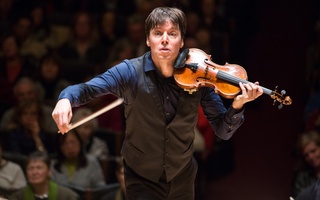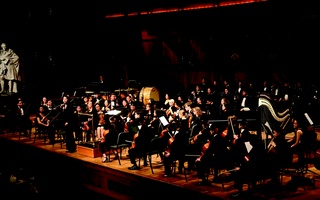On Saturday, the Harvard-Radcliffe Orchestra played Gustav Mahler’s “Totenfeier” and Jean Sibelius’s Symphony No. 2 with elegance and poignant melodic sensibility. Led by conductor and music director Federico Cortese, the undergraduate orchestra delivered an enthralling performance for Junior Parents’ Weekend in Sanders Theatre.
Mahler’s “Totenfeier,” or “Funeral Rites,” may be best known as the opening movement to his Symphony No. 2, but the composer conceived of the piece originally in 1888 as a stand-alone tone poem. While Mahler modified the piece considerably for its inclusion in his later symphony, the original composition represents an important moment in his musical career and deserves adequate recognition. The somber piece carries an immense aesthetic gravity: As he stated in later program notes, Mahler intended the piece as a contemplation of questions of life and death.
Overall, the orchestra effectively conveyed the piece’s emotional intensity. In places where Mahler’s score is sparse, the orchestra’s sound was thin. For the most part, however, the orchestra conveyed the tremendous variety in timbre and the rich texture of the music with dexterity and passion.
As the concert continued, the orchestra seemed to gain confidence and cohesion. The second piece on the program was Sibelius’s Symphony No. 2, which the composer himself described as “a confession of the soul.” Perhaps most beloved and best-known of Sibelius’s seven symphonies, the composition was crucial to his rise as a composer and as a Finnish cultural hero.
On Saturday night, HRO gave full expression to the symphony’s bold, adventurous lyricism. The woodwinds handled the sections in which they played alone with simultaneous zest and ease, while the brass provided a warm tone throughout, with moments of golden-hued glory. The bassoons handled their sweetly melodic theme in the second movement with finesse. The strings shone throughout the performance: They held a consistent mellifluous timbre and were the primary driving force of the tension and release that pulled the symphony forward. They excelled during the fast scherzo of the symphony’s third movement, hovering with incredible energy above the brass and percussion that formed the backbone of the orchestra’s sound.
The fourth and final movement of Sibelius’s symphony was the climactic moment of both the piece and HRO’s performance. The violins, led by concertmaster Emma J. Frucht ’17 skillfully built up, then reined in, then set free the melodic momentum. The piece ended on a shimmering note of vibrato in the high strings, which beautifully dissolved into silence—and then, of course, applause.
—Staff writer Theresa A. Byrne can be reached at theresa.byrne@thecrimson.com.
Read more in Arts
Boston Ballet Presents Stunning 'Onegin'Recommended Articles
-
 Joshua Bell and Academy of St Martin in the Fields Stun Symphony Hall
Joshua Bell and Academy of St Martin in the Fields Stun Symphony Hall -
Boston Modern Orchestra Project Elevates Great Contemporary ClassicalThe concert, billed as “A special tribute to Steven Stucky,” indeed provided a fitting commemoration to the contemporary American giant while also doing justice to the works of the other composers featured on the program.
-
 HRO Winter Concerto Short but Sweet
HRO Winter Concerto Short but Sweet -
 80 Years of Music: An Interview with Joan Tower, Trailblazing Composer
80 Years of Music: An Interview with Joan Tower, Trailblazing Composer -
Joan Tower Celebrates an 80-Year Journey with Concert at Jordan HallThe Boston Modern Orchestra Project (BMOP), and featuring soloists Carol Wincenc and Adrian Morejon and conducted by Gil Rose, performed Tower’s music stunningly and with an evocative sense of the landscapes the music represented.













